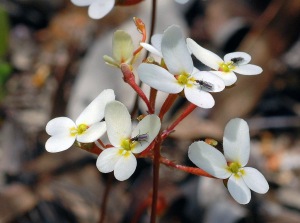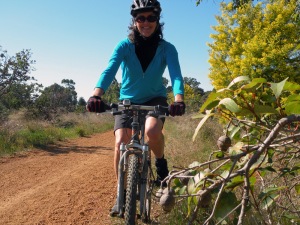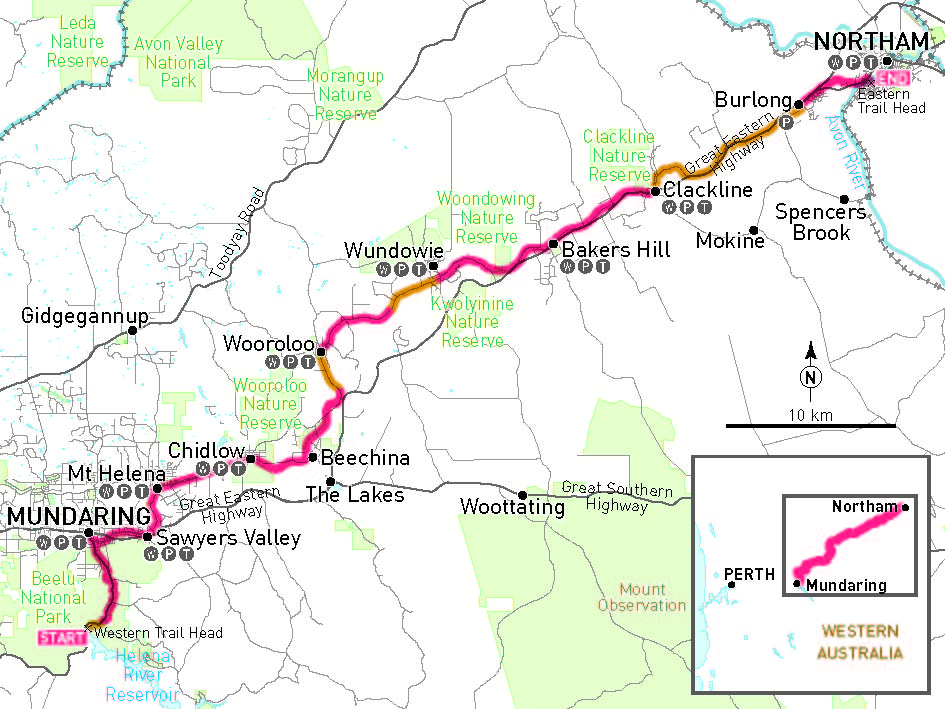Western Australia’s Kep Trail is rich in history, mapping the watering holes that served generations of early Australians, and makes for a relaxing weekend ride, discovers Debra Mayrhofer.

Located right on Perth’s doorstep and named after the Nyoongar word for water, the Kep Track includes significant sites such as Mundaring Weir, Chidlow Wells, the Avon River and, of course, the iconic Kalgoorlie–Perth water pipeline.
The multi-use trail, designed for bike riders, walkers and horse-riders, connects the hills area of Perth with the Avon Valley, following the route used previously between water stops by Aboriginal groups, gold prospectors, timber workers and farmers.
For some of its 75kms the Kep runs alongside the water pipeline, but whenever the pipeline takes a shorter route with a steep gradient, the trail sticks to the gentler line of the railway, providing an extremely accessible off-road adventure for bike riders of all abilities.
Both trail heads are accessible by public transport with some planning and there is plenty of parking at the various villages along the route for those who don’t want to ride the whole track.
The western trail head is located at the Mundaring Weir Hotel, about a 40 minute drive east of Perth. The hotel was built in 1898 to cater for tourists and officials during the construction of the weir. After falling into disrepair it has been restored to its former glory and is a popular resting place for those seeking a cold beer, hot meal or overnight stay as part of their Kep adventure.
From the hotel there is a bit of a climb as the track follows the weir spur line into the Mundaring township, but the beauty of vegetation alongside the path distracts from the effort of the ascent. The track passes through the Mundaring Sculpture Park on the edge of the town and you are likely to encounter plenty of bike riders in this area, as the Kep, Munda Biddi and Railway Reserve tracks all intersect here. The township has cafes, a hotel, supermarket, small museum and visitor centre.
As you leave the Sculpture Park the pipeline disappears underground and you need to keep an eye out for the distinctive metal Kep Track markers as you follow the original route of the Eastern Railway. Take care crossing the Great Eastern Highway, after which you rarely encounter traffic.
At the 12km mark you ride through the hamlet of Sawyers Valley named for its role in the timber-cutting history of the region. Sawyers Valley offers a service station and a variety of small shops, as well as places to refill your water bottles and a picnic area.
The multi-use trail, designed for bike riders, walkers and horse-riders, connects the hills area of Perth with the Avon Valley, following the route used previously between water stops by Aboriginal groups, gold prospectors, timber workers and farmers.
After meandering through the forest, the trail arrives at Chidlow, which was not only a timber settlement but an important re-watering point for trains. The railway dam that was built to supply water for steam is now a recreational site known as Lake Leschenaultia. Although it is about two kilometres off the Kep Track, it is well worth a visit for either a quick swim, a ride on the single-track or even an overnight stay.
Wooroloo has a small general store and a park with toilets, BBQ and picnic facilities. From Wooroloo the track continues through Wundowie, which has similar facilities, and on to Baker’s Hill. This stretch is one of my favourite parts of the ride, passing through deep cuttings in heavily wooded forest. The cuttings were mostly hand-made, with a bit of help from dynamite in places, and the sheer effort that must have gone into carving a path through the granite slabs is awe-inspiring.

Baker’s Hill, at the 50km mark, is home to the famous Pie Shop, which many people assume gave the village its name, but it is actually named after the foreman of one of the railway gangs. Nonetheless, the baked goods are an unmissable feature of this ride, so a stop here is almost compulsory. There is also another cafe, camping area, toilets and BBQ facilities.
From Clackline, there are about six kilometres of sealed road close to the pipeline. The Kep no longer follows a rail route from here to Northam, so be prepared for a few more undulations. The track also becomes a bit softer and the final descent towards Northam is quite deep pea gravel but still manageable on a hybrid with decent tread on the tyres.
Weary travellers will find that the picturesque town of Northam, nestled on the banks of the Avon River, caters for all their end-of-trip needs. While you are there, be sure to check out the suspension bridge, which is said to be the longest in Australia, and the town’s famous white swans. From Northam there is the opportunity for bike tourists to explore more of the Avon Valley by taking the relatively quiet local roads through York or Toodyay.
Despite the prevalence of rail trails in Western Australia, actual rail transport for potential cycle tourists is abysmal. There is no public transport from the township of Mundaring to the trail head, which is about 4km away. There is one train per weekday which runs from Northam to Perth in the morning and returns in the evening. It does carry bikes (for an extra $10) but they need to be pre-booked. There is also a coach service between Perth and Northam. Metropolitan buses don’t carry bikes. For more information visit www.transwa.wa.gov.au.
Some riders like to put the hammer down on the Kep, covering Mundaring- Northam-Mundaring in a single day but it seems a pity not to take the time to stop and soak up the history of this route. After all, the water in the pipeline is only travelling at three kilometres an hour!
Distance: 75km
Difficulty: Easy
Surface: Compacted gravel and road
Scenery: Mostly bush, some open farmland
Web link: www.keptrack.com.au
Ride On content is editorially independent, but is supported financially by members of Bicycle Network. If you enjoy our articles and want to support the future publication of high-quality content, please consider helping out by becoming a member.



One thought on “2”